Celebrating Clay County History: A soldier named Julius Heileman
CLAY COUNTY – Brevet Lt. Col. Julius Heileman lay on his cot at Fort Drane near Micanopy. He was sweaty and feverish. The exhaustion he felt was unbearable. He lain sick like this for days, his …
This item is available in full to subscribers.
Attention subscribers
To continue reading, you will need to either log in to your subscriber account, or purchase a new subscription.
If you are a current print subscriber, you can set up a free website account and connect your subscription to it by clicking here.
If you are a digital subscriber with an active, online-only subscription then you already have an account here. Just reset your password if you've not yet logged in to your account on this new site.
Otherwise, click here to view your options for subscribing.
Please log in to continueDon't have an ID?Print subscribersIf you're a print subscriber, but do not yet have an online account, click here to create one. Non-subscribersClick here to see your options for subscribing. Single day passYou also have the option of purchasing 24 hours of access, for $1.00. Click here to purchase a single day pass. |
Celebrating Clay County History: A soldier named Julius Heileman
CLAY COUNTY – Brevet Lt. Col. Julius Heileman lay on his cot at Fort Drane near Micanopy. He was sweaty and feverish. The exhaustion he felt was unbearable. He lain sick like this for days, his skin yellow with jaundice and blood seeping from his nose. The camp surgeon could do little for him. The battle at Micanopy took the last of his strength. Through eyes clinched tight with delirium, we can imagine him looking back on his life.
Born in 1787 in Granville, Massachusetts, to a doctor named Johan Frederich Heileman and his wife Olive Robinson, Julius was destined to serve his country. His father was from Claustal, Rendsburg-Eckernforde, Schleswig-Holstein, Germany. His mother, Olive Robinson, was the daughter of an American reverend.
Johan Frederich Heileman came to America and served as a company surgeon in the forces of the English ally, Germany, during the American Revolution. He was a General Riesdel’s German Brigade member in General Burgoyne’s Army. Johan was captured at the battle of Bennington, and somewhere along the way to the prison camp, he either escaped or deserted. He married Olive and had three children with her, Julius being the youngest. Johan made a good life for himself and his family in America, his adopted country.
When Julius was 16, he was accepted to West Point as a cadet. Laying on his cot, he thought about the harsh marching drills, the difficult engineering courses, and the classes on conducting warfare. He chose artillery when he graduated in 1806 as the 12th graduate of West Point.
Commissioned a second lieutenant, he would be a soldier on the battlefield, leading men from in front, not the rear. The Army sent him first to various garrisons around the Atlantic seaboard, and he was able to serve in the War of 1812. As he lay on his thin blankets, he thought about his promotion: First Lieutenant in 1808 and then Captain in 1813. He thought about the cold weather at some of his postings guarding forts like Sacketts Harbor, New York and Ft. Niagara, New York. The cold and the snow were very different from Florida’s heat, humidity, and sweltering sun. Even the enemy he was guarding against was so different. Here in Florida, his foe was a tough, unforgiving, and proud people – the Seminoles. They took no prisoners.
Julius rolled over on his side and folded his arms tightly across his chest, groaning. He looked back in pride on May 1823, when the Army recognized his ten years of faithful service and made him a Brevet Major. He was stationed at Ft. Monroe in Virginia, then onto Ft. Moultrie in Charleston – the same fort the Seminole warrior Osceola would be held prisoner and died at in 1838. He thought about how much he had loved his first wife, Henrietta Auchmutz, when he married her in 1814 and how much it hurt when she died in 1823. She had been with him in Charleston and then gone back home to Boston. She died there of an undetermined illness.
He thought about his second wife, Ann Mason, and of the children. Ann was the daughter of George Mason. Julius thought about the old man who was so important to the young country. At Philadelphia in 1787, Mason was most outspoken at the Constitutional Convention. He exerted great influence, but during the last two weeks of the convention, he decided not to sign the constitution. Two of Mason’s greatest concerns were later incorporated into the document. The Bill of Rights addressed one concern, and the 11th Amendment addressed his desire for control of the judiciary.
Who was going to take care of Ann and the children now? Julius was distraught. But, by 1835, Julius was sent to Florida. General Winfield Scott had come through the forks of Black Creek and understood its valuable strategic location. He ordered then-Maj. Heileman to proceed immediately and build a garrison there, an armory, a supply depot. Julius got to work on this huge task.
He remembered how hot it was, how black the water was, how deep and cool it was. The fort was right at Garey’s Ferry, a ferry run by Samuel Garey. He remembered the snakes, the fleeting deer, the graceful water birds and the creeping alligators. He thought about how many of his men seemed to be sick all the time with fevers, dysentery, scurvy, and the occasional drowning.
He thought about his greatest battle on the day he fought the Seminoles near Micanopy. It was June 7, 1836. He felt pride in his chest at the way he raced out front of the cannon and led his men from the front. The president promoted him for his past gallantry and meritorious service just two days before, on June 25. But alas, the sun was setting. Julius’ breathing stopped, and he passed onto that great battlefield in the sky, a soldier just fading away.
Fort Heileman, Clay County’s Seminole war-era fort that once stood in modern-day Middleburg, is named after its founder and defender, Brevet Lt. Col. Julius Frederick Heileman. Located at the modern-day Main Street boat ramp, the fort was the major supply depot for North Florida during the Second Seminole War. The Indian Removal Act brought on the war and was signed into law by President Andrew Jackson on May 28, 1830. The law authorized the president to grant lands west of the Mississippi in exchange for Indian lands within existing state borders. A few tribes went peacefully, but many resisted the relocation, especially the Seminoles. The tribe, after everything was said and done, remains undefeated to this day.











